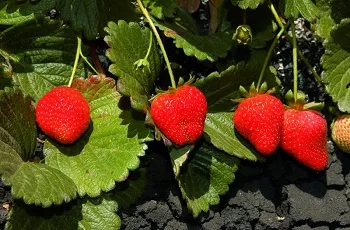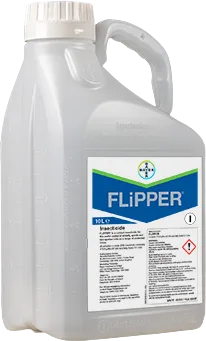

FLiPPER
FLiPPER is a broad-spectrum contact bio-insecticide/acaricide for control of whitefly, aphids and mites on protected crops of strawberry, tomato and cucumber.
Product details
FLiPPER is a broad-spectrum contact bio-insecticide/acaricide for control of whitefly, aphids and mites on protected crops of strawberry, tomato and cucumber. EAMUs are available for a wide range of pests in a variety of fruit and vegetable crops.
Containing fatty acids derived from a natural by-product of extra virgin olive oil, FLiPPER is exempt from maximum residue limit (MRL) testing and has a zero-day post-harvest interval for all crops. It has minimal impact on bees, pollinators and beneficial arthropods.
As well as several extensions for authorisation of minor use (EAMU) in conventional production systems, FLiPPER is also approved for use in organic crops.
FLiPPER is a contact bio-insecticide/acaricide for the effective control of aphids, whiteflies, thrips and spider mites and good control of mealybugs, leafhoppers, psyllids, suckers and scale insects. It is effective against all insect and spider mite life stages, particularly against motile forms.
Product Profile
Important Information
*Bayer’s suggested application rate for FLiPPER is 1.0 L of product per 100 L of water, equivalent to an inclusion rate of 1%.
FLiPPER is a bioinsecticide/ acaricide that is active following CONTACT with the pest body. It is active against all stages of insects and mites: juveniles and adults, as well as eggs.The effectiveness of FLiPPER’s active substance – unsaturated carboxylic acids (carbon chain lengths C14 - C20) – is achieved by the lipophilic carbon chains penetrating the external layers of the target pest. The unsaturated part of the carbon chains interacts with multiple vital metabolic processes. This interferes with feeding activity, resulting in mortality. Rapid mortality occurs once the insect comes in to contact with a sufficient dose. The first visible effect is the immediate cessation of feeding activity. A sub-optimal dose will result in mortality being achieved over a more prolonged period. The results being reduced feeding, egg lay and egg viability.
Why you need FLiPPER
Provides lasting control of pest populations when applied as per instructions
Fits well with IPM/ICM programmes and biological control programmes
Has no cross resistance with other insecticides; controls strains of insects and mites resistant to other active substances
Formulation provides high levels of security to users and the environment
Has no residual activity and degrades rapidly in the environment
Application timing – all crops
Initiate applications at the first signs of the pest infestation build-up.
FLiPPER should always be used in accordance with the label at full recommended rates for maximum benefit in terms of insect control and resistance management.
Make applications at the first signs of infestation build-up, or when founding colonies of the target pest appear, with the standard rate of 1% v/v (1 L of formulated product in 100 L of spray solution).
Apply in the period of day when the pest is likely to be most vulnerable to contact. Aim to target all stages, especially juveniles.
Preferably treat in the morning, in warm temperatures, avoiding the peak heat of the day.
Always use clean spraying equipment, ensuring all residues from previous applications have been removed from the spray tank and spray lines. Check to ensure correct functionality of nozzles for optimum application.
Use good quality soft water, avoid hard water over with more than >300 parts per million CaCO₃ equivalent in water hardness. Conduct a jar test if water hardness is high and
correct if required.Where hard water is found, include a non-acidifying water conditioner such as X-Fusion from De Sangosse. Bayer has also conducted limited efficacy testing and selectivity testing with Align from IntraCrop and Tri- sodium salt of citric acid (TCSATSCA) and found both to be physically and chemically compatible with FLiPPER. Always follow the label instructions of your chosen water conditioner to ensure the correct mixing sequence.
FLiPPER is readily miscible in water, so use minimum agitation during preparation and application to avoid the formation of foam.
Use the spray solution immediately following preparation. Do not store for future use as this may lead to some separation and consequent dilution of effect.
Ensure complete wetting of the target pests, aiming to achieve good placement of the solution on the target foliage and covering the different areas on the plant where the respective pests are located (including the underside of the leaves, if applicable).
Use the most suitable means of application available to achieve the desired coverage. Small drop Guardian Air nozzles give a good number of drops per litre while fan jet give more drops per litre but are less easy to control with poorer retention and deposition as a consequence. Avoid the use of hollow cone nozzles as trials with vegetable crops found that the spray tends to go around the plants, and to drift. Angled nozzles tend to give better coverage than vertical nozzles as the spray is directed around all sides of the plant. Where there is a need to apply FLiPPER to the underside of the canopy, drop leg systems should be considered. In orchards or soft fruit systems, mist blowers and air sleeve systems can be effective, but must be properly set up for the crop in question.
Assess the effects not earlier than 48-hours after application and repeat if necessary, after seven days in case of heavy attack or re-infestation.
DO NOT MIX FLiPPER with Copper, Sulphur, acidic products or products containing metal ions as they may be physically incompatible and may cause phytotoxicity.
In case of tank mixes with other products, FLiPPER must always be the product that is added last to the spray tank.
There is no residual activity, no translaminar or systemic effects, and no residual persistence.
Conditions for application
Aphids
Best results are achieved with colonies of 10-40 individuals/shoot. With very high populations individuals shielded from the spray may restart the infestation and will require a second treatment
If leaves are curled, use FLiPPER in sequence with systemic partners, such as Movento in brassicas and other field vegetables or with Batavia in top and soft fruit.
Whiteflies
Target larvae or nymphs to better control the infestation build up.
On low-height or creeping plants, regulate the pressure and nozzle orientation to achieve full coverage.
On crops with vertical growth, target the basal foliage to control the juveniles and higher leaves against adults.
Thrips
Target juveniles and adults.
Set the spraying action to reach flowers and wet thoroughly the vegetation.
Consider applying in combination with predator insects, such as Orius laevigatus, Amblyseius cucumeris, Amblyseius montdorensis, Amblyseius swirskii.
Mites
Wet the vegetation with suitable volume on both sides of leaves.
Consider applying in combination with phytoseids mites such as Phytoseiulus persimilis, Amblyseilus californicus.
Psyllids
Monitor the presence of Anthocorids and treat when they are well established.
Leafhoppers
Achieve a complete wetting of the suckers (Scaphoideus titanus).
Remove weeds along the vine row before application to ensure wetting of suckers.
Scales and mealybugs
Regulate volume and spraying pressure to enable the spray solution to penetrate the vegetation and fruit, where individuals are hidden.
Be careful of any undesired effect on fruits and grapes, avoiding treatment at the highest temperature and runoff of product to the bottom of berries.
Application method
Aubergine, pepper and chilli
Apply FLiPPER for the control of aphids, whitefly and spider mite in permanent glasshouses with full enclosure.
Application is to be made via hydraulic boom sprayer in a minimum of 400 L water/ha.
Ornamentals
Apply FLiPPER for the control of aphids, whitefly and spider mite in permanent glasshouses with full enclosure.
Application is to be made using handheld sprayers in a water volume 400-1600 L/ha.
Leafy vegetables and fresh herbs – angelica, baby leaf crops, balm, basil, bay, caraway leaves, celery leaves, chervil, chives, coriander leaves, cress, dill leaves, edible flowers, endive, fennel leaves, herb – other, hyssop, lamb’s lettuce, land cress, lettuce, lovage leaves, marjoram, mint, oregano, parsley, purslane, red mustard, rocket, rosemary, sage, salad burnet, savory, spinach, spinach beet, sweet cicely, tarragon, thyme, watercress in propagation, chamomile, ginkgo, ginseng, hibiscus flowers, lime flowers, mallow, rose petals, strawberry leaves, valerian.
Apply FLiPPER for the control of Aphids (Aphididae), Western Flower Thrip (Frankliniella occidentalis), thrips (Thrips tabaci) and spider mite (Tetranychus urticae).
Application is to be made using high-volume broadcast spray equipment, conventional hydraulic boom applicators or hand-held sprayers to outdoor crops in 300-500 L water/ha and to protected crops in 400-1000 L water/ha.
Field vegetables – carrot, celeriac, horseradish, Jerusalem artichoke, parsley root, parsnip, radish, red beet, salsify, swede, turnip, bulb onion, garlic, salad onion, shallot, asparagus, celery, Florence fennel, Globe artichoke, leek, rhubarb, courgette and summer squash, sweetcorn, winter squash and pumpkin, broccoli/calabrese, Brussels sprout, cabbage, cauliflower, choi sum, collard kale, kohlrabi, oriental cabbage, beans without pods (fresh), broad bean (fresh), dwarf French bean, edible podded pea, lentil (fresh), runner bean, vining pea.
Apply FLiPPER for the control of thrips (Thrips tabaci), Aphids (Aphididae) and cabbage aphid.
Application is to be made using high-volume broadcast spray equipment, conventional hydraulic boom applicators or hand-held sprayers to outdoor crops in 300-500 L water/ha and to protected crops in 400-1000 L water/ha.
Soft fruit – bilberry, blackberry, blackcurrant and redcurrant, blueberry, cranberry, elderberry, gooseberry, loganberry and rubus hybrid, mulberry, raspberry, rose hips, strawberries.
Apply FLiPPER for the control of Aphids (Aphididae), two spotted spider mite (Tetranychus urticae), Western Flower Thrip (Frankliniella occidentalis), leaf hoppers, Strawberry blossom weevil (Anthonumus rubi), Thrips (Thrips fuscipennis) and white fly.
Application is to be made using high-volume broadcast spray equipment, conventional hydraulic boom applicators or hand-held sprayers to outdoor crops in 400-1000 L water/ha and to protected crops in 400-1000 L water/ha.
Tree nuts, Pome fruit, Stone fruit and Wine grapes – almond, apple, apricot, cherry, chestnut, hazelnut, peach and nectarine, pear, plum, quince, walnut, wine grapes
Apply FLiPPER for the control of Aphids (Aphididae), two spotted spider mite (Tetranychus urticae) and blossom weevil.
Application is to be made using broadcast air assisted fruit tree sprayers in 400-1000 L water/ha.
Featuring multiple modes of action, FLiPPER can be used to replace or support conventional chemistry in the interests of resistance management.
IPM compatibility
In IPM programmes apply FLiPPER in combination with predators or parasitoids of the target pest, such as Cryptolaemus montrouzieri.
FLiPPER has no repellent effect either on bees or on arthropods other than bees. Regulatory evaluation has concluded that the FLiPPER may be applied during flowering – except when pollinators are actively foraging – and does not pose risk to bumble bees or honeybees if direct spraying with full coverage is avoided.
In protected crops, hives should be closed during spraying but can be safely re-opened once the product has dried (estimated 6-12 hours after spraying in standard conditions).
SOURCE: IOBC toxicity class according to studies conducted at IPM Impact, Nederhespen Belgium, 2014-2016.
IOBC rating:
1 = Harmless
2 = Slightly harmful
3 = Moderately harmful
4 = Harmful